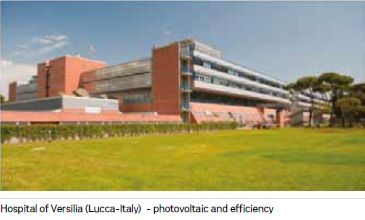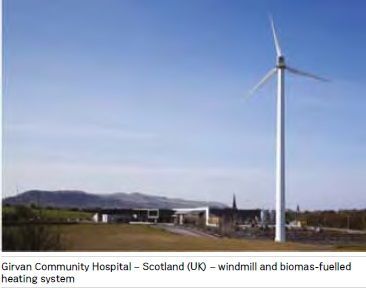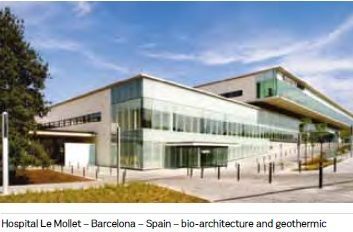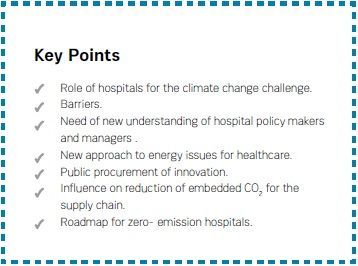HealthManagement, Volume 15 - Issue 3, 2015
The Challenge of Our Times
Recent years have seen an increasing awareness that climate change is of dramatic importance not only for its impact on the environment, but also on human health. The last message has been launched by a relevant religious and moral leader: Pope Francis with his Encyclical “Laudato si” (Francis 2015).
Those who are working in healthcare, from policymakers to daily hospital operators, should be more aware that health facilities could be instrumental in the fight to reduce greenhouse gas (GHG) emissions.
In 2010, the Health and Environment Ministries of the EU met in Parma (Italy) at the 5th Ministerial Conference on Environment and Health and made a joint commitment to “increase the health sector’s contribution to reducing greenhouse gas emissions and strengthen its leadership on energy and resource efficient management” (World Health Organization Regional Office for Europe 2010).
This article aims to highlight, based on several EU projects led by the authors namely-Renewable Energy Systems (RES)-Hospital (www.res-hospitals.eu), EcoQUIP: delivering efficiency, quality, and sustainability in healthcare (www. ecoquip.eu) and Energy4Health (http:// www.ecoquip.eu/about-ecoquip/ associated-projects.html), that it is possible for hospitals to make a much greater contribution by taking a strategic approach to energy-related investment in energy efficiency and by stimulating sustainable innovation from the chain of goods and services of hospital suppliers.
Why is Energy a Strategic Issue for Hospital Management?
Energy is definitely relevant for hospitals, which are institutions that work on a 24/7 basis 365 days of the year. They are clearly energy-intensive buildings but, due to their societal role, have not been exposed to the same scrutiny from the environmental lobbyists as the industrial sector. The stock of existing hospitals in the 28 EU Countries has been estimated at around 26,000 facilities (European Commission Joint Research Centre Institute for Prospective Technological Studies, 2013), and the European healthcare system is responsible for about 5% of the total production of CO2 emissions of the EU.
The efficient use of energy by hospitals and the type of energy they use can and should be considered as having great relevance not only for the contribution to “environmental health”, but for enhancing their very mission to heal people. The question therefore remains: “why is such an important issue being ignored by healthcare managers and why do efforts not seem to achieve more relevant results?”
The project “Toward zero carbon hospitals with renewable energy systems” (RES-Hospitals) was designed with the specific goal of exploring the non-technical barriers to the exploitation of energy efficiency measures and renewable energy systems in hospitals and understanding how to tackle or at least minimise those obstacles (www.res-hospitals.eu). It was co-financed by the European Commission Executive Agency for Competitiveness and Innovation (EACI) (now Executive Agency for Small and Medium-sized Enterprises (EASME)) in the framework of the Intelligent Energy for Europe programme.
The Need for a Multi-Faceted Approach
The initial action of RES-Hospitals was a survey, in 2011, among the hospitals’ managers in the countries participating in the project: France, Holland, Hungary, Italy, Poland, Spain, UK (Scotland). It was aimed at understanding their perception and vision on the above-mentioned barriers.
The economic aspects and the related difficulties in getting financing for the investments ranked first, which was obvious, considering the financial crisis across the public sector in Europe. But was this the only reason?
Other interesting aspects emerged from the answers, shedding light on additional significant barriers.
• Hospital managers paid little attention to energy, due to its relatively low ranking in hospital costs, compared with staff and medicinal expenditures;
• The matter was considered only a technical issue; it was not felt as part of their mission;
• New technologies were looked at with diffidence, considered not sufficiently tested;
• The supply chain was felt to be unprepared and unreliable in producing valid solutions.
Changing the perception of the health policymakers appeared, therefore, to be one of the important goals. Consequently selecting good practices and diffusing the most advanced approaches was one of the goals of the project that was realised with the publication of the Renewable Energy Guide for European Hospitals, which was widely disseminated through the website www.res-hospitals.eu and a number of workshops, conferences and congresses. Paper copies were also delivered to policymakers in the countries involved in the pilot studies.
Parallel work by organisations such as Health Care Without Harm (HCWH), published in scientific publications issued during recent years, has obviously contributed to widely diffusing the message. A Lancet report, arguing that tackling climate change could be the greatest global health opportunity of the 21st century, has given authoritative support in changing the way the matter is seen, at least by an important layer of policymakers and managers. The attitude of “energy is not my business” is, however, still the norm.
The need to increase managerial awareness that energy has become a strategic issue has to be conceived as a continuous process, that should focus on making clear and understood:
• The importance of the contribution that hospitals can make to the climate change challenge;
• The relevance of the matter of sustainability, even in economic terms;
• The importance of guaranteeing patient comfort with the control of energy efficiency; The trust in technological development and innovative solutions;
• The need for a proactive attitude with regard to the economic barriers, by researching and exploiting existing and new financial tools.
Great Results are Possible on the Road Toward Hospitals with Zero Emissions
The RES-Hospitals project conducted pilot studies in 18 hospitals across the seven EU Member States participating in the project: five in Spain, four in Italy, three in the Netherlands and Poland and one each in France, Hungary and the UK (the pilot studies are available on request from each partner) (www.covenantofmayors.eu/ actions/sustainable-energy-actionplans_ en.html).
The goal of the pilot studies was to prove that it was possible, by the year 2020, for hospitals to produce 50% of energy consumption from renewable (green) energy onsite, including reduction of their energy consumption through efficiency measures.


The equally important objective has been to focus on energy and matters normally considered technical such as the convergence of interest of the policymakers (contributing for financial aspects), the health sector (for the impact on patients), staff and patients (awareness of the importance of habits and behaviour).
The studies also considered how each of the hospitals could reach a zero carbon position sometime in the future and this started to open their minds to wider and more collaborative solutions including community energy systems and collaboration with other stakeholders.
To consider a few examples, the Spanish participants focused mostly on biomass to reach the target of 50% of renewable energy produced on site. The Italian participants have presented solutions utilising photovoltaic and thermal solar, supported in a couple of cases by additional biomasses.
In the Dutch case the possibility of the hospitals producing wind energy, both on and off-site, was considered, but the national incentives were less attractive than in some other countries. A more radical approach was then explored to exploit deep geothermal resources to power not only at the hospitals but also some other local energy-intensive sites such as a zoo.
Two situations emerged that provided important lessons for existing European hospitals. One was the hospital Sant’Orsola of Bologna, which given its size and its urban location, at the present stage of technology development, does not have the possibility to produce on-site the necessary green energy. The procurement of biofuel and of green energy from outside the hospital will be essential and has to be associated with extensive measures for energy efficiency for its 31 pavilions constructed over four centuries.
The opposite situation is when hospitals have large areas available and a location favourable to green energy production. They could become producers of green energy even in excess of what would be needed to satisfy their own needs, and therefore, could generate much needed additional revenue to fund a better healthcare service.
In these situations especially, it becomes more economically feasible to consider an alliance between the hospital and its community. This is, in fact, another area where there is need for more collaborative thinking by publicly-funded organisations. For example the Covenant of Mayors has so far paid very little attention to hospitals in their Sustainable Energy Action Plan (SEAPs).
RES-Hospitals concluded in November 2013, but the issues that were highlighted have been explored further in an EU-funded policy roadmap project (Energy4Health) during the past 18 months. The policy roadmap was launched in March 2015 and the authors hope to implement the conclusions through a Horizon 2020 project (www. ecoquip.eu/about-ecoquip/associatedprojects. html).
The Hospital for a Cultural Change to Address the Big Societal Challenges
As well as the Energy4Health policy roadmap project, the results of RES-Hospitals have also partly influenced the establishment of a joint thematic action group on energy within the wider EcoQUIP project, which is aimed at demonstrating how the approach of Public Procurement of Innovation (PPI) can improve the efficiency, quality and sustainability of healthcare.
Through this project, some hospitals are adopting new approaches to achieve their strategic objectives through PPI. One of these is the Nottingham University NHS Trust in the UK, which launched a market-sounding proposal for novel solutions for its future energy needs that received a response from a wide variety of innovative businesses. The option currently being explored is a modular hydrogen fuel cell-powered combined heat and power (CHP) system.
Another important point is that hospitals also need to consider the embedded impact in their supply chain as well as their own activities. One way to do this is to use the Scope 1, 2 and 3 emissions approach in the internationally-recognised Greenhouse Gas Protocol accounting system (www. ghgprotocol.org) (see Image1).

The Roadmap Toward Hospitals at Zero Emissions
The Energy4Health project mentioned above was funded to support the EU Demand-Side Action Plan and was one of six projects aimed at ‘Building and Implementing Strategic Roadmaps of Demand-Side Policy Measures to Boost Demand for Industrial Innovation’.
The aim was to develop and secure stakeholder commitment for a strategic policy roadmap to improve the framework conditions that influence the demand for and market uptake of innovative solutions in the healthcare sector. It engaged with a broad spectrum of stakeholders. The activity has led to eight operational objectives that comprise the Energy4Health roadmap:
1. Encouraging and facilitating the development of sector level National Energy Efficiency Action Plans and National Renewable Energy Action Plans;.
2. Providing evidence of the scale of fossil fuel use in the European healthcare sector;
3. Improving knowledge exchange on sustainable energy management in the healthcare sector;
4. Raising awareness of alternative funding options for transformation of energy infrastructures;
5. Encouraging community and district level energy partnerships;
6. Raising awareness of the link between energy efficiency and patient wellbeing;
7. Developing a European benchmarking database of energy consumption and production;
8. Encouraging the sustainable energy technology sector to consider the healthcare sector as a lead market for new and improved solutions.
It is hoped that the Energy4Health Roadmap will be adopted by influential stakeholders both directly and through participation in a proposed Horizon 2020 implementation action to be known as E4H-PLUS.

The Continuation of Action and Advancing Goals
The experience of the RES-Hospital and Energy4Health projects has provided clear evidence that hospitals and healthcare policymakers need to be more strategic about addressing the future energy and climate impact challenges of the sector. The E4HPLUS project will bring together influential stakeholders to assist the healthcare sector (public authorities) in the definition and implementation of sustainable energy policies and measures. The longer-term aim should be to reduce the negative impact to zero and to be more collaborative with both the municipalities and the energy technology innovators in realising such an aspiration. This should be based on common awareness on one hand that the fight for the environment is also “hospital business” and on the other hand that the hospital is not a “world apart”

References:
European Commission Joint Research Centre Institute for Prospective Technological Studies (2014) European hospital survey: benchmarking deployment of ehealth services (2012-2013) [Accessed: 28 July 2015] Available from http:// ec.europa.eu/digital-agenda/en/news/europeanhospital- survey-benchmarking-deploymentehealth- services-2012-2013
Francis (2015) Encyclical letter laudato si’of the holy father Francis on care for our common home, 24 May. [Accessed: 28 July 2015] Available from http://w2.vatican.va/content/francesco/en/encyclicals/ documents/papa-francesco_20150524_enciclica- laudato-si.html
Health Care Without Harm (2015) Climate and health. [Accessed: 29 July 2015] Available from http://noharm-global.org/issues/global/ climate-and-health
RES-Hospitals (2013) Renewable energy guide for European hospitals. The publication can be downloaded in English, Italian and Spanish from http://www.res-hospitals.eu/ renewable-energy-guide-for-european-hospitals
Watts N, Adger WN, Agnolucci P et al. (2015) Health and climate change: policy responses to protect public health. Lancet, 24 June, pii: S0140-6736(15)60854-6. doi: 10.1016/S0140- 6736(15)60854-6. [Epub ahead of print] World Health Organization Regional
Office for Europe (2010) Parma declaration on environment and health. Fifth Ministerial Conference on Environment and Health, 10-12 March, Parma, Italy, [Accessed: 28 July 2015] Available from http://www.euro. who.int/en/publications/policy-documents/ parma-declaration-on-environment-and-health
Energy for Health Project Summary (2015). [Accessed: 29 July 2015] Available from http:// www.ecoquip.eu/about-ecoquip/associated-projects. html
















